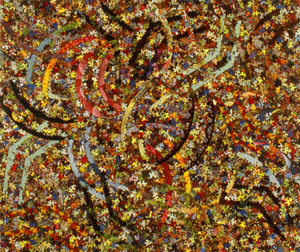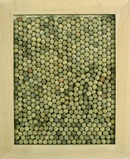Working
PUZZLES
By Tom Patterson, WINSTON-SALEM JOURNAL
Years of exploration brought ”painter” to create layered compositions
with glue and unfinished jigsaw puzzles.
When artist Al Souza mentions his recent “paintings,” he is not referring to works that he made using oils, acrylics or brushes. Instead, the medium he uses to make these works is glue, and his raw materials are jigsaw puzzles.
That’s right, jigsaw puzzles. Since the mid-1990s Souza has been actively collecting finished or partly finished jigsaw puzzles, then juxtaposing and layering fragments from them onto wood-panel backings to create the boldly hued, kaleidoscopically organized compositions that he calls paintings. The largest of them measure 6-by-7 feet and are six puzzles deep.
 Nineteen such pieces are included in Souza”s 38-piece exhibition, “Al Souza: Inverse Warp Field,” scheduled to open at the Southeastern Center for Contemporary Art on Friday evening, beginning with an informal “art talk” by Souza at 6 p.m.
Nineteen such pieces are included in Souza”s 38-piece exhibition, “Al Souza: Inverse Warp Field,” scheduled to open at the Southeastern Center for Contemporary Art on Friday evening, beginning with an informal “art talk” by Souza at 6 p.m.
In a recent telephone interview, Souza discussed his puzzle-derived works and the cut-and-layered works he makes from preprinted paper, which make up the other half of his SECCA show. He also talked about how he was diverted into art from his previously chosen career path as an engineer, and about how his work has evolved over the 35 years since that time.
Souza was studying civil engineering at the University of Massachusetts in the late 1960s, when he took an art-department course in two-dimensional design in order to fulfill his degree program”s lone humanities requirement. He said that after two class sessions, his instructor recognized the depth of his interest in the contrasting principles of design and destruction. As a result, Souza was freed from the requirement of attending class and allowed to use the instructor’s studio to experimentally pursue that interest wherever it led him.
“Before that (experience), I though art was just about drawing figures or painting landscapes,” he said. “I didn’t realize that art could be about what something looked like when it was destroyed.”
Souza went on to complete his requirements for a bachelor’s degree in civil engineering, which he earned in 1967, but the design class stimulated an abiding passion for art making that he continued to nurture. After finishing his undergraduate work, he found a job as a helicopter designer for an aeronautical engineering firm in Connecticut, but in his spare time he continued his art-making activities and took classes at the Art Students League in nearby New York. Souza said that he was bothered by the fact that his employer supplied helicopters to the U.S. military forces for use in the Vietnam War, to which he was morally and politically opposed. As a result, he resigned his job in 1970, returned to his alma mater, and spent two years earning a master’s degree in painting. Since that time, he has supported himself largely by teaching art – at 10 other colleges or universities before 1992, when he joined the art faculty at the University of Houston, where he remains employed as a full professor.
Souza said that he was influenced early on during his career by, and in some cases worked directly with, well-known avant-garde artists active in Europe and the United States during the late 1960s and early ’70s. Joseph Beuys, Yoko Ono, John Cage and others involved in the loosely defined, playfully experimental movement known as Fluxus, were among them.
Having started out as a painter in the usual sense of that term, Souza went on during the late 1970s and ’80s to work in a number of different mediums, including photography and assemblage. He made the first of his works in which jigsaw-puzzle pieces were primary materials in 1979, when he used three separate jigsaw puzzles to created a 16-part series of photographs in which a baseball appears to morph into a tennis ball that finally is transformed into a football. He then used puzzles and the same 16-stage technique to transform an image of a Corsican seaside resort into a view of a village in the Austrian mountains.
A series of later works paired informal personal snapshots with wax-transfer reproductions of them, and he said that the process of making the reproductions led him back into painting by the end of the 1980s. He began collecting amateur paintings from thrift stores and painting over parts of them, and during the early 1990s he attached barnacles to a number of his canvases.
In 1995 Souza began making works by cutting up and displaying fragments of paintings that he had made earlier. Soon afterward, in a related gesture, he began meticulously cutting ellipses into newspaper pages, maps, wallpaper and sheet music, then layering the cut pages one atop the other in as many as 10 layers.
He said that the latter works, 19 of which are in his show at SECCA, were strongly influenced by composer Cage’s “Fontana Mix,” in which holes were randomly placed in pre-existing sheet music to reveal notes from the music sheet directly underneath it.He said that he typically makes these works when he is away from his studio and working as an artist-in-residence.
In the late 1990s Souza returned to working with jigsaw puzzles, but this time he eliminated the photographic component of his earlier puzzle-based works and began creating assemblages like his those to be shown at SECCA. In these, the puzzles are only fragmentarily completed, glued in place with the fragments overlapping one another and interspersed with pieces apparently strewn and glued down at random.
Souza collects jigsaw puzzles in a wide variety of image categories, including architecture, plants, food, art supplies and famous artworks, and he most often thematically organizes his compositions accordingly. He said that he doesn’t assemble the puzzles himself but rather buys them from puzzle hobbyists or accepts them as gifts, always at least partially pre-assembled. He said that it usually takes him about two weeks to finish one of his larger puzzle works, and estimated that he has made between 300 and 400 of them.
 In explaining his reference to them as “paintings,” Souza said, “I look at them structurally the same way a painter would. I usually have fragments of about 30 puzzles spread around on my studio floor, then I get up on a ladder and make decisions – ”I want a chunk of that puzzle, I want a chunk of that one.” The whole room becomes my palette.” The resultant compositions “work in the same sort of way that a painting does,” he said.
In explaining his reference to them as “paintings,” Souza said, “I look at them structurally the same way a painter would. I usually have fragments of about 30 puzzles spread around on my studio floor, then I get up on a ladder and make decisions – ”I want a chunk of that puzzle, I want a chunk of that one.” The whole room becomes my palette.” The resultant compositions “work in the same sort of way that a painting does,” he said.
Having repeatedly changed his artistic approach during the first two decades of his art career, Souza said that he is now content to alternate between making his cut-paper pieces, his “paintings” and another ongoing series of paper “Spit Balls,” two of which are included in the SECCA show. “I”m very happy with what I’m doing, because I’ve found something that’s really mine,” he said.
“Al Souza: Inverse Warp Field” will open at SECCA on Friday with Souza’s informal “art talk” at 6 p.m. followed by a reception from 7 to 9 p.m. The exhibition will remain on view through April 3. For more information, call 725-1904.
